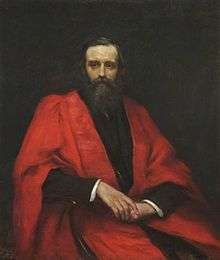Arthur Woollgar Verrall

Arthur Woollgar Verrall (5 February 1851, Brighton – 18 June 1912, Cambridge) was a British classics scholar associated with Trinity College, Cambridge, and the first occupant of the King Edward VII Chair of English. He was noted for his translations and for his challenging, unorthodox interpretations of the Greek dramatists, such as his commentary on Agamemnon; his detractors found his readings contorted and too ingenious, too often overlooking obvious explanations in favour of the convoluted, and his published work is nowadays not highly regarded.[1] After his death, admirers M. A. Bayfield and J. D. Duff edited Verrall's Collected Literary Essays. Classical and Modern and Collected Essays in Greek and Latin Scholarship 1914. Among his publications, Euripides the Rationalist was highly influential. He was a member of the Cambridge Apostles, a secret society, from 1871.
Life
Arthur Woollgar Verrall was the son of a solicitor.[2] He was educated at Twyford School, Wellington College, and Trinity College, Cambridge, where he graduated BA as 2nd Classic in 1872.[3] Elected a fellow of Trinity in 1874, he was a College Lecturer from 1877 to 1911. In February 1911, he was appointed to fill the new King Edward VII professorship of literature at Cambridge, which had been endowed by Harold Harmsworth.[2] He married Margaret De Gaudrion, born 21 December 1857, died 2 July 1916, in 1882. A Trinity Tutor from 1889 to 1899; he was tutor to Aleister Crowley.
His wife Margaret Verrall, a lecturer in classics at Newnham College, gained more fame through her psychic researches — an interest Arthur shared[4] — and as a medium. She was a member of a Cambridge group who were early explorers of Spiritualism and automatic writing.[5] Their daughter Helen married William Henry Salter, who was later President of the Society for Psychical Research (1947–48). Mother and daughter were among mediums involved in the Palm Sunday Case, in which messages from the deceased Mary Catherine Lyttleton (who died on 21 March 1875) were supposedly transmitted by automatic writing to her lover Arthur Balfour.[6]
He is buried at the Parish of the Ascension Burial Ground in Cambridge, with his wife and daughter Phoebe Margaret De Gaudrion Verrall (1888-1890); his wife was a member of the Ladies' Dining Society, of which there were 12 members. A portrait of Verrall by Frederic Yates is in the collection of Trinity College, Cambridge.[7]
References
- ↑ Richard Smail, ‘Verrall, Arthur Woollgar (1851–1912)’, Oxford Dictionary of National Biography, Oxford University Press, 2004.doi:10.1093/ref:odnb/36646
- 1 2
 Chisholm, Hugh, ed. (1922). "Verrall, Arthur Woollgar". Encyclopædia Britannica (12th ed.). London & New York.
Chisholm, Hugh, ed. (1922). "Verrall, Arthur Woollgar". Encyclopædia Britannica (12th ed.). London & New York. - ↑ "Verrall, Arthur Woollgar (VRL869AW)". A Cambridge Alumni Database. University of Cambridge.
- ↑ Shils, Edward; Blacker, Carmen (1996). Cambridge women: twelve portraits. Cambridge University Press. p. 30. ISBN 0-521-48344-1.
- ↑ Rita McWilliams Tullberg, ‘Verrall , Margaret de Gaudrion (1857–1916)’, Oxford Dictionary of National Biography, Oxford University Press, Sept 2004; online edn, May 2007. doi:10.1093/ref:odnb/48503
- ↑ Oppenheim, Janet (1988). The Other World: Spiritualism and Psychical Research in England, 1850-1914. Cambridge University Press. pp. 132–133. ISBN 0-521-34767-X.
- ↑ "Trinity College, University of Cambridge". BBC Your Paintings.
External links
| Wikisource has original works written by or about: Arthur Woollgar Verrall |
- Works by Arthur Woollgar Verrall at Project Gutenberg
- Works by or about Arthur Woollgar Verrall at Internet Archive
- Arthur Woollgar Verrall at Find a Grave
- Vita of Mrs A.W. Verrall